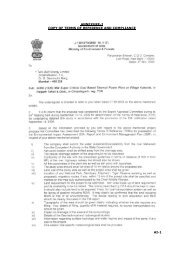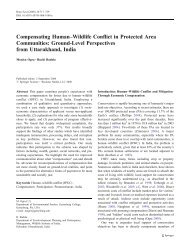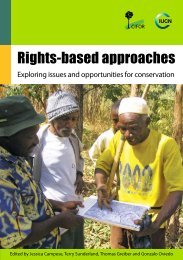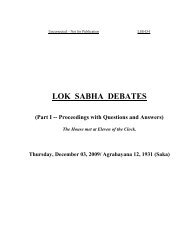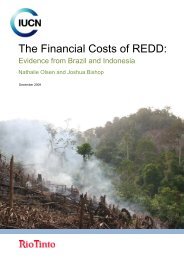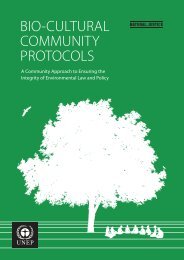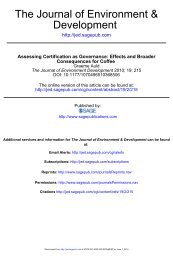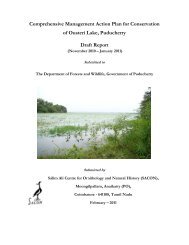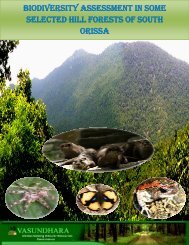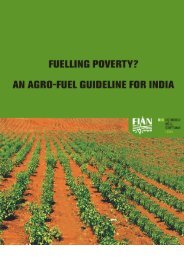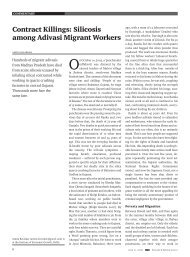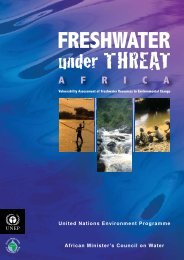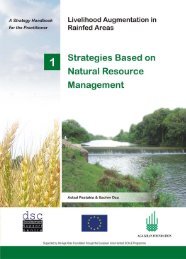Catalyzing Climate and Disaster Resilience: Processes for Identifying
Catalyzing Climate and Disaster Resilience: Processes for Identifying
Catalyzing Climate and Disaster Resilience: Processes for Identifying
You also want an ePaper? Increase the reach of your titles
YUMPU automatically turns print PDFs into web optimized ePapers that Google loves.
143<br />
Sheikh Rashid Ahmed, the then Minister <strong>for</strong> Railways <strong>and</strong> a long time resident <strong>and</strong><br />
politician of the city, publicly claimed that the Lai Expressway Project was a result of<br />
his ef<strong>for</strong>ts. In the public gathering on 27 March in Rawalpindi, he said that the<br />
Expressway was his dream that had been materialized by the President (Dawn, 2007b).<br />
This was confirmed by one of the officials of the RDA (implementing agency of the<br />
project) that he floated the idea during 2002-2004 to the President <strong>for</strong> his consideration.<br />
In 2007, he began to mobilize his election campaign around this mega project. On 27<br />
March 2007, a big public gathering was organized in Liaquat Bagh, where the President<br />
made the announcement <strong>and</strong> inaugurated the project claiming that the Lai Expressway<br />
will change the face of the city (Dawn, 2007b). At the time, the project had not been<br />
approved by the Planning Commission. The President also announced that people<br />
relocated by the project should be given a better deal than their present housing,<br />
which was also endorsed through the directive issued by the then Prime Minister the<br />
same month. The President also announced an elevated expressway on Murree Road,<br />
widening of Airport Road, a Rawalpindi bypass from Rawat, <strong>and</strong> in recognition of<br />
the ef<strong>for</strong>ts of Sheikh Rashid Ahmed, the Lai Expressway was renamed as the Sheikh<br />
Rashid Expressway.<br />
Comparing Urban Flood Mitigation Options: Costs <strong>and</strong> Benefits<br />
in Rawalpindi, Pakistan<br />
On the other h<strong>and</strong>, the Government of the Punjab, which was sharing 50% of the cost<br />
of the project, did not seem to be in favor of this project because of its high cost,<br />
estimated at PKR 16 billion at that time. There were numerous smaller or mediumscale<br />
development projects that could be launched in different districts to mobilize<br />
voters <strong>for</strong> the upcoming election across the province, rather than investing so much<br />
money in one city. The dispute over costs <strong>and</strong> cost-sharing were also reflected in the<br />
minutes of the proceedings of the first Steering Committee meeting held on 15 May<br />
2007, where the Deputy Chairman of the Planning Commission emphasized that the<br />
Government of Punjab should own the project <strong>and</strong> release the required amount at<br />
the earliest possible date. The Federal Government made a commitment to allocate<br />
200 million in Public Sector Development Programme, 2007-2008 <strong>and</strong> the<br />
Government of Punjab was asked to make equivalent allocation in the Annual<br />
Development Programme, 2007-2008.<br />
Given the personal interest of the President, the project processing <strong>and</strong> preparatory<br />
studies were completed in record time. The feasibility study was carried out in 15<br />
days by National Engineering Services Pakistan (NESPAK), while approval from<br />
ECNEC (the highest body to approve the project above PKR 500 million) came<br />
immediately. The Expressway was declared a special scheme <strong>and</strong> the governmentowned<br />
NESPAK was entrusted with the tasks of design <strong>and</strong> research, while the Frontier<br />
Works Organization (FWO, a subsidiary of Pakistan Army) was named the executing<br />
organization. The Rawalpindi Development Authority was supposed to act as<br />
coordinating agency. Contracts were awarded to NESPAK <strong>and</strong> FWO without<br />
competitive bidding, which is required <strong>for</strong> any development project. Additionally,<br />
the unit rates quoted by FWO <strong>for</strong> the project were higher by 25% compared to the<br />
st<strong>and</strong>ard approved unit rates by the Government of Punjab. According to the contract<br />
submitted to <strong>and</strong> approved by the Punjab Government, FWO was supposed to design,<br />
execute <strong>and</strong> commission the project within a stipulated period of two years’<br />
turnaround time.



